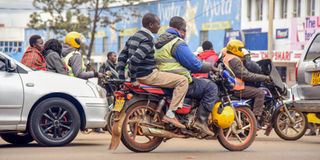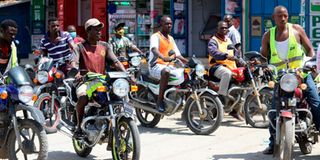Premium
Highways of death: Most deadly roads for motorcyclists

2024 data shows that Mombasa and Kangundo roads are the most dangerous, followed by Thika Super Highway, Jogoo and Outer Ring roads.
What you need to know:
- Boda passengers ditched the helmet because it was unclean or simply because they feared it would ‘spoil their hair’. - National Helmet Wearing Coalition Report
A new report has given an insight into the most dangerous roads for motorcyclists and their passengers in Nairobi.
The report, titled ‘Fare Price; An Investigation into the Health Costs of Motorcycle Taxi Crashes in Kenya’, compiled by the National Helmet Wearing Coalition in partnership with the Motorcycle Initiative, Transaid and the UK-based FiA Foundation, tracked road safety data between May 2022 and October 2023 to compile the report.
It identified five key roads in Nairobi as highways of death where automobiles, pedestrians, riders and bystanders alike are locked in a macabre tango. A dance of death.
Mombasa and Kangundo roads were identified as the most dangerous, followed by Thika Super Highway, Jogoo and Outer Ring roads.
The report sought to investigate the health costs of boda boda-related/linked accidents and to understand the level of helmet use among drivers and passengers.

Boda boda riders wait for clients at Makutano Township, Kapenguria.
It also found that almost two-thirds of boda boda operators (63 per cent) were observed wearing helmets while riding, but this varied by location, with the case study being Nairobi roads.
The Outer Ring Road had the lowest rate of helmet use by operators at 56.5 per cent, while Thika Road had the highest at 70.5 per cent.
The report found several possible explanations for the differences in helmet use by location, not least the fact that the traffic police headquarters is located on Thika Road.
“Observations showed that the location of the Traffic Police HQ inevitably led to more frequent episodes of police surveillance, resulting in higher helmet use by operators than in other locations,” the report said.
The findings, released on Monday, show that over a 17-month period, 9,996 people were directly affected by motorcycle accidents.
Data from the National Police Service shows that between May 2022 and October last year, of the 9,996, a total of 2,384 died, 5,581 were seriously injured, while 2,031 escaped with minor injuries.
“Based on this data, the most likely outcome for motorcyclists involved in a crash is serious injury (56 percent), with the second most likely outcome being death (24 percent). However, it may be the case that minor injuries are less likely to be reported to the police and do not require hospital treatment,” the report says.

Boda boda riders.
Some 249 victims suffered head injuries and each spent close to Sh3 million on treatment, while those with limb injuries were 149 and spent close to Sh1.6 million each, while survivors with multiple injuries were 128 and spent up to Sh1 million each on medical expenses.
There were 128 survivors with multiple injuries, each spending up to Sh1 million on medical expenses.
Twenty-five of the victims sustained abdominal injuries, each spending Sh320,740 on medical costs, while seven sustained chest injuries, each spending Sh109,475 on hospital bills.
Ninety-one percent of patients were male, with an average age of 31 years. The average age of female patients was also 31.
“As expected, the majority of victims were in the lower age groups for both women and men, with 68 per cent of women and 75 per cent of men aged 35 or under; this mode of transport is considered to be more accessible to young people, both operators and passengers,” it said.
The National Transport and Safety Authority (NTSA) reported a slight decrease in the total number of road deaths in 2023 (4,324) compared with 2022’s (4,432).
However, the WHO’s 2023 estimated Kenya’s road traffic fatality rate at 28 per 100,000 population, which translates to 14,926 road traffic deaths per year, suggesting that many incidents go unreported.
“The International Road Federation reported approximately 2,258,800 motorcycle taxi operators in Kenya in 2021, a figure that has almost doubled since 2017,” the report adds.
As expected, this growth has come at a cost. Of the 4,324 road traffic fatalities reported in Kenya in 2023, motorcycle-related deaths accounted for 35% (1,526), and this number is expected to rise.
The report also points out that there is no existing data specifically related to the economic burden that motorcycle injuries place on health services in Kenya.
“This lack of data is pervasive and limits the ability to link the severity of injuries to whether or not the rider was wearing a helmet at the time,” it says.
The report urged law enforcement agencies to act to ensure that riders obey the rules of the road.
It also called on the public to change their aversion towards wearing protective gear.
“Enforcement is a recurrent factor influencing whether or not a motorcyclist decides to wear a helmet, suggesting that more vigorous enforcement would lead to an increase in helmet use,” the report said.
It also found that boda boda riders were more likely to be fined for not having a licence or proof of insurance than for not wearing a helmet. Helmet use among passengers was significantly lower than among drivers, with only 15% of the 1,385 passengers observed wearing a helmet while riding a motorcycle.
Boda boda operators interviewed for the report said that the main reasons for not wearing a helmet were related to enforcement in certain areas, particularly in central Nairobi.
Longer distances and wet weather are perceived as posing a greater risk to the rider, so helmets are worn on such occasions. In a minority of cases, passengers insisted on wearing a helmet.
Passengers said that they were rarely provided with helmets by boda boda operators, with most having only one helmet.
Others revealed that hygiene was a factor, with most claiming that where the operator did have a helmet for the passenger, it was either unclean or simply they refused to wear it for fear of ‘spoiling their hair’.





